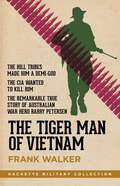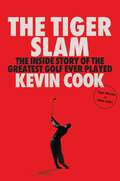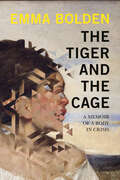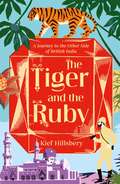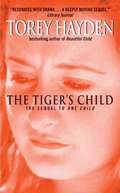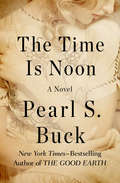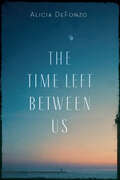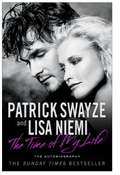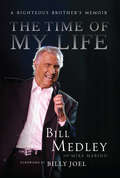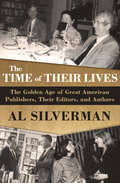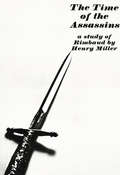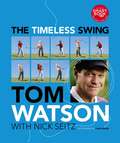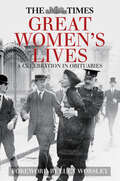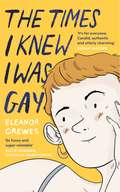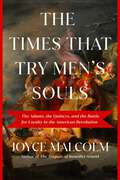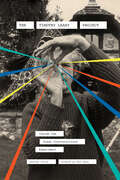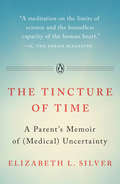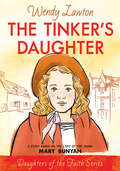- Table View
- List View
The Tiger Man of Vietnam (Hachette Military Collection)
by Frank WalkerThe Vietnamese hilltribes made him a demi-god. The CIA wanted to kill him. This is the remarkable true story of Australian war hero Barry Petersen.As he flew over South East Asia towards Vietnam, Captain Barry Petersen struggled to keep an aura of calm. Inwardly he was incredibly excited. Aged 28, highly trained, with experience in anti-communist guerilla warfare, he was about to embark on the biggest and most important mission of his life.In 1963, Australian Army Captain Barry Petersen was sent to Vietnam. It was one of the most tightly held secrets of the Vietnam War: long before combat troops set foot there and under the command of the CIA, Petersen was ordered to train and lead guerilla squads of Montagnard tribesmen against the Viet Cong in the remote Central Highlands.Petersen successfully formed a fearsome militia, named 'Tiger Men'. A canny leader, he was courageous in battle, and his bravery saw him awarded the coveted Military Cross, and worshipped by the hill tribes.But his success created enemies, not just within the Viet Cong. Like Marlon Brando's character in 'Apocolyse Now', some in the CIA saw Petersen as having gone native. His refusal, when asked, to turn his Tiger Men into assassins as part of the notorious CIA Phoenix Program only strengthened that belief. The CIA strongly resented anyone who stood in their way. Some in the US intelligence were determined Petersen had to go and he was lucky to make it out of the mountains alive. The Tiger Man of Vietnam reveals the compelling true story of little-known Australian war hero Barry Petersen.'One of those great untold stories and Walker tells it with verve and excitement and, with meticulous attention to detail' - Sydney Morning Herald'Drips with adventure and intrigue and has at its centre a personality boys of all ages will identify with' - The Age'Walker's finely researched book goes beyond the biographical account of an Australian war hero' - Sun Herald'Walker's book about Petersen, The Tiger Man Of Vietnam, is well-crafted and racily written' - Weekend Australian
The Tiger Queens
by Stephanie ThorntonIn the late twelfth century, across the sweeping Mongolian grasslands, brilliant, charismatic Temujin ascends to power, declaring himself the Great, or Genghis, Khan. But it is the women who stand beside him who ensure his triumph.... After her mother foretells an ominous future for her, gifted Borte becomes an outsider within her clan. When she seeks comfort in the arms of aristocratic traveler Jamuka, she discovers he is the blood brother of Temujin, the man who agreed to marry her and then abandoned her long before they could wed. Temujin will return and make Borte his queen, yet it will take many women to safeguard his fragile new kingdom. Their daughter, the fierce Alaqai, will ride and shoot an arrow as well as any man. Fatima, an elegant Persian captive, will transform her desire for revenge into an unbreakable loyalty. And Sorkhokhtani, a demure widow, will position her sons to inherit the empire when it begins to fracture from within.In a world lit by fire and ruled by the sword, the tiger queens of Genghis Khan come to depend on one another as they fight and love, scheme and sacrifice, all for the good of their family...and the greatness of the People of the Felt Walls.
The Tiger Slam: The Inside Story of the Greatest Golf Ever Played (Tiger Woods in 2000–2001)
by Kevin Cook&“A captivating tale.&” —Kirkus Reviews • &“Masterful.&” —Mark Frost • &“The rare must-read.&” —Alan Shipnuck • &“This book is truly as grand as it gets.&” —Jim NantzTwenty-five years ago, Tiger Woods achieved the greatest feat in golf history: the &“Tiger Slam.&” Now, for the first time, the award-winning author of Tommy&’s Honor delivers a riveting account of Tiger at his most brilliant—dominating the game in a way we will never see again.In 1997, as every schoolchild knows, Tiger Woods won the Masters by the largest margin in history, becoming the first Black player to win a major championship. Four years later, the world watches with breathless anticipation as he returns to Augusta National, aiming for a milestone no other golfer has ever achieved: four professional Grand Slam triumphs in a row. In The Tiger Slam, Kevin Cook delivers a gripping, inside-the-ropes account of an astonishing streak of victories that left Woods&’s rivals scrambling to keep up. Readers will hear from many of golf &’s biggest names—Tiger&’s caddie, his coach, his opponents, his idols, and others, all offering fresh insight into the electrifying highs of his victories and the obstacles on and off the course that threatened his relentless pursuit of perfection. We join Tiger at the beginning of his Slam: the 2000 US Open at Pebble Beach. In a notoriously grueling tournament designed to bring golfers to their knees, who could even dream of winning by a record margin of fifteen strokes? Tiger could. We follow him to the hallowed grounds of St. Andrews a few weeks later for the 2000 Open Championship, where he transforms his game to meet the singular demands of the links. Still only twenty-four, he leaves the Old Course as the youngest player ever to complete a career Grand Slam. We proceed with Tiger to the 2000 PGA Championship at Valhalla, where he fights a spectacular Sunday duel with a player he grew up idolizing, ending with a playoff that changes the course of golf history. Finally, we return to legendary Augusta National, site of his record-breaking first major championship, to see if he can be the first to sweep all four majors. Dogged by reports of an early-season slump, facing a supposedly &“Tiger-proofed&” course, golf&’s superstar tees off against his two fiercest adversaries in an unforgettable final round. The Tiger Slam is the epitome of greatness in sport, a feat as exhilarating today as it was twenty-five years ago. In fact, it&’s even more so, now that we know we&’ll never see its like again—such dominance is unthinkable in modern golf&’s era of parity. Kevin Cook invites us to close our eyes and remember a young champion at the peak of his powers: unmatched raw strength, single-minded focus, strategic genius, and utter fearlessness. The Tiger Slam takes readers behind the scenes in the thrilling months when Tiger Woods took an ancient game to new heights.
The Tiger and the Cage: A Memoir of a Body in Crisis
by Emma BoldenFor readers of Susannah Cahalan&’s Brain on Fire and Porochista Khakpour&’s Sick, this exquisitely wrought debut memoir recounts a lifelong struggle with chronic pain and endometriosis, while speaking more broadly to anyone who&’s been told &“it&’s all in your head&” In Catholic grade school, Emma Bolden has a strange experience with a teacher that unleashes a short-lived, persistent coughing spell—something the medical establishment will later use against her as she struggles through chronic pain and fainting spells that coincide with her menstrual cycle. With The Tiger and the Cage, Bolden uses her own experience as the starting point for a journey through the institutional misogyny of Western medicine—from a history of labeling women &“hysterical&” and parading them as curiosities to a lack of information on causes or cures for endometriosis, despite more than a century of documented cases. Recounting botched surgeries and dire side effects from pharmaceuticals affecting her and countless others, Bolden speaks to the ways people are often failed by the official narratives of institutions meant to protect them. Bolden also interrogates a narrative commonly imposed on menstruating bodies: the expected story arc of marriage and children. She interrogates her body as a painful site she must mentally escape and a countdown she hopes to beat by having a child before a hysterectomy. Only later does she find language and acceptance for her asexality and the life she needs to lead. Through all its gripping, devastating, and beautiful threads, The Tiger and the Cage says what Bolden and so many like her have needed to hear: I see you, and I believe you.
The Tiger and the Ruby: A Journey to the Other Side of British India
by Kief HillsberyIn 1841, Nigel Halleck left Britain as a clerk in the East India Company. He served in the colonial administration for eight years before leaving his post, eventually disappearing in the mountain kingdom of Nepal, never to be heard from again. A century-and-a-half later, Kief Hillsbery, Nigel&’s nephew many times removed, sets out to unravel the mystery. Tracing his ancestor&’s journey across the subcontinent, his quest takes him from Lahore to Calcutta, and finally to the palaces of Kathmandu. What emerges is an unexpected personal chapter in the history of the British Empire in India.
The Tiger in the Attic: Memories of the Kindertransport and Growing Up English (Black Literature And Culture Ser.)
by Edith MiltonIn 1939, on the eve of Hitler's invasion of Poland, seven-year-old Edith Milton (then Edith Cohn) and her sister Ruth left Germany by way of the Kindertransport, the program which gave some 10,000 Jewish children refuge in England. The two were given shelter by a jovial, upper-class British foster family with whom they lived for the next seven years. Edith chronicles these transformative experiences of exile and good fortune in The Tiger in the Attic, a touching memoir of growing up as an outsider in a strange land. In this illuminating chronicle, Edith describes how she struggled to fit in and to conquer self-doubts about her German identity. Her realistic portrayal of the seemingly mundane yet historically momentous details of daily life during World War II slowly reveals istelf as a hopeful story about the kindness and generosity of strangers. She paints an account rich with colorful characters and intense relationships, uncanny close calls and unnerving bouts of luck that led to survival. Edith's journey between cultures continues with her final passage to America—yet another chapter in her life that required adjustment to a new world—allowing her, as she narrates it here, to visit her past as an exile all over again. The Tiger in the Attic is a literary gem from a skilled fiction writer, the story of a thoughtful and observant child growing up against the backdrop of the most dangerous and decisive moment in modern European history. Offering a unique perspective on Holocaust studies, this book is both an exceptional and universal story of a young German-Jewish girl caught between worlds. “Adjectives like ‘audacious’ and ‘eloquent,’ ‘enchanting’ and ‘exceptional’ require rationing. . . . But what if the book demands these terms and more? Such is the case with The Tiger in the Attic, Edith Milton’s marvelous memoir of her childhood.”—Kerry Fried, Newsday “Milton is brilliant at the small stroke . . . as well as broader ones.”—Alana Newhouse, New York Times Book Review
The Tiger's Child
by Torey L. HaydenThis book is a sequel to _One Child_, in which Hayden tells the story of her work with a six-year-old emotionally disturbed child named Sheila. In this book, Hayden chronicles the renewal of her relationship with Sheila, now fourteen and still struggling to come to terms with her past.Hayden and Sheila both must come to terms with their different perceptions of those first five months they spent together as teacher and student.
The Tightening Dark: An American Hostage in Yemen
by Benjamin Buchholz Sam FarranThis riveting memoir follows a Lebanese-Muslim-American and thirty-year US Marine veteran who suffered a six-month ordeal at the hands of a brutal regime in Yemen—and remained loyal to his country through it all. As air strikes carpeted Yemen's capital, Sam Farran was one of only a few Americans in the war-ravaged country. He was there to conduct security assessments for a variety of international firms. Days after his arrival, he was brutally seized and taken hostage by Houthi rebels. Sam would spend the next six months suffering a horrific ordeal that would test his endurance, his loyalty and his very soul. Every day his captors asked him—as a fellow Muslim—to betray America and his Marine heritage in exchange for his freedom. Would he give in to the Houthis and return to his Middle Eastern roots? In the end--and despite daily threats to his life—Sam found the strength to resist, and came out of his ordeal with an increased sense of being, foremost, a US Marine. The Tightening Dark is an intimate, riveting and inspiring memoir of heroic strength, courage, survival and commitment to country. And a reminder that the best parts of the American dream are the dreamers—those who pledge to being American, regardless of where they are born.
The Time Has Come: Why Men Must Join the Gender Equality Revolution
by Michael KaufmanIn the vein of Tim Wise’s White Like Me and Sheryl Sandberg’s Lean In, The Time Has Come —by co-founder of the White Ribbon campaign Michael Kaufman — offers a plain-spoken and forthright look at why and how men must actively fight for gender equality.From founding the White Ribbon Campaign, the world’s largest organized effort of men working to end violence against women, in the early 1990s, to his appointment as the only male member of the G7 Gender Equality Advisory Council, Michael Kaufman has been a major figure in promoting social justice and women’s rights for decades. Now, in The Time Has Come, he issues a stirring call for men to mobilize in the movement for gender equality.Weaving together sociological data, personal experiences, and insights gleaned from decades of work with governments and NGOs around the globe, Kaufman explores topics ranging from domestic violence to parental leave, grappling with the ways in which a culture of toxic masculinity hurts women and men (and their children). Informative and provocative, The Time Has Come demonstrates how real gender equality creates advancements in both the workplace and the global economy, and urges men to become dedicated allies in dismantling the patriarchy.
The Time Is Noon: A Novel
by Pearl S. BuckA woman looks back on her long, rocky path to fulfillment in this revealing novel by the New York Times–bestselling author of The Good Earth. Considered one of the most personal and autobiographical novels by the Nobel and Pulitzer Prize–winning author, The Time Is Noon tells the story of Joan Richards and her journey of self-discovery during the first half of the twentieth century. As a child, Joan finds her individuality obscured by her place in her family and her small town. In her adulthood, her struggle to discover her true self continues—but is inhibited by an unhappy marriage. After breaking free from her husband, she begins a stark reassessment of the way she&’s been living—and to her surprise, learns to appreciate all that lies ahead—in this elegant novel of chances lost and reclaimed, a beautifully affirming story of one woman&’s journey to maturity. This ebook features an illustrated biography of Pearl S. Buck including rare images from the author&’s estate.
The Time Left between Us
by Alicia DeFonzoA blend of memoir, history, and oral storytelling, The Time Left between Us bridges the gap between the generation who fought World War II and the generation who has forgotten it. Alicia DeFonzo takes an unplanned visit to the Normandy beaches while staying in Paris. Her grandfather &“Del&” (Anthony DelRossi) had fought in World War II, and she becomes distraught after realizing how little she knows about the war and his experiences, which until then had remained largely unspoken. Across landscapes and lifetimes DeFonzo retraces her beloved grandfather&’s tour through World War II Europe. The eighty-four-year-old DelRossi recounts stories as an army combat engineer surviving major campaigns, including Normandy, St. Lo, the Bulge, Hürtgenwald, and Remagen, then liberating concentration camps. In this braided narrative, we see DeFonzo&’s childhood in a traditional Italian American family with an erratic Marine Corps father and a beloved grandfather. Spanning ten years, DeFonzo&’s travels and research take an unexpected detour after she inherits a Nazi Waffen-SS diary from her grandfather, and, in her final trip, returns to Germany to confront the diary owner&’s family. DeFonzo&’s and her grandfather&’s stories merge when Del undergoes open-heart surgery and Alicia must be the one to safeguard the past. Both nostalgic and gripping, The Time Left between Us is a meditation on how deeply connected the past is to the present and how the truth—and what we remember of it—are fragmented.
The Time of My Life
by Patrick Swayze Lisa NiemiIn January 2008, movie star Patrick Swayze was given the worst news of his life. What he hoped was just a stomach ache was actually stage four pancreatic cancer, a diagnosis that is fatal within a year for 79% of the people to whom it is given. Remarkably, Patrick is not just alive a year later but continuing his treatment, and responding well. But this book isn't just the story of Patrick's fight against cancer. In the public eye from the early 1980s, this is the story of a remarkable life and career. Intended as a low budget, straight-to-video production, Dirty Dancingbecame a cult hit and remains one of the most enduring films of the 80s. Ghost cemented Patrick as a hugely bankable star, in a role that has had a considerable cultural impact. Most recently Patrick has returned to the public's adoring arms in TV's The Beast. This book will chronicle Patrick's personal life as well -- including his treatment for alcoholism following the death of his father and sister's sudden death. What has remained a constant in Patrick's life is his marriage and Patrick and Lisa's love story is inspiring, honest, heartfelt and transcends the typical celebrity marriage. This is a book that anyone who has faced cancer or a terminal illness can turn to: Lisa and Patrick have shown the world that cancer isn't just a diagnosis given to one individual, but a disease that can bring a household together or pull a family apart. Bold, honest and inspiring, Patrick Swayze's memoir is the story of a remarkable man's life and career and of his refusal to give in.
The Time of My Life: A Righteous Brother's Memoir
by Bill Medley Mike Marino Foreword by Billy JoelFrom an early age, Bill Medley had a passion for music. School glee club and amateur singing contests soon gave way to the albums of Ray Charles and Little Richard. That raw R&B influence would profoundly shape Medley’s musical future. As the pioneering "blue-eyed soul” group the Righteous Brothers, Bill Medley and late partner Bobby Hatfield sang such huge hits as "(You’re My) Soul and Inspiration,” "Unchained Melody,” and "You’ve Lost That Lovin’ Feelin’,” the latter recognized by BMI as the most-played song of the twentieth century. Medley’s duet with Jennifer Warnes for the Dirty Dancing soundtrack, "(I’ve Had) the Time of My Life,” became a worldwide No. 1 single on its way to winning an Oscar, a Grammy, and a Golden Globe. But Medley’s story isn’t just about the hits and the awards. It’s about an immensely talented man who reached the pinnacle of fame, success, and excess, until the shocking murder of his wife, Karen. In time, this tragedy eventually helped him renew his commitment to both faith and family.
The Time of Their Lives: The Golden Age of Great American Book Publishers, Their Editors, and Authors
by Al SilvermanA lively portrait of a fascinating and tumultuous period in American book publishing According to Al Silverman, former publisher of Viking Press and president of the Book-of-the-Month Club, the golden age of book publishing began after World War II and lasted into the early 1980s. In this entertaining and affectionate industry biography, Silverman captures the passionate spirit of legendary houses such as Knopf; Farrar, Straus and Giroux; Grove Press; and Harper & Row, and profiles larger-than-life executives and editors, including Alfred and Blanche Knopf, Bennett Cerf, Roger Straus, Seymour Lawrence, and Cass Canfield. More than one hundred and twenty publishing insiders share their behind-the-scenes stories about how some of the most famous books in American literary history--from The Rise and Fall of the Third Reich to The Silence of the Lambs--came into being and why they're still being read today. A joyful tribute to the hard work and boundless energy of professionals who dedicate their careers to getting great books in front of enthusiastic readers, The Time of Their Lives will delight bibliophiles and anyone interested in this important and ever-evolving industry.
The Time of the Assassins: A Study of Rimbaud
by Henry MillerThis study is not literary criticism but a fascinating chapter in Miller's own spiritual autobiography. The social function of the creative personality is a recurrent theme with Henry Miller, and this book is perhaps his most poignant and concentrated analysis of the artist's dilemma.
The Timeless Swing
by Tom Watson Nick SeitzTom Watson, a few months short of his sixtieth birthday, led the 2009 British Open with one hole to play and came within an unlucky bounce of winning it for the sixth time. His stunning performance electrified the golf world and showcased a swing that has endured as a model of good mechanics, rhythm, and repeatability. In The Timeless Swing, Watson draws on all the knowledge and expertise he has accumulated over the course of his extraordinary career, imparting lessons that will help golfers of any age play to the best of their abilities and enjoy the game more. From fundamentals like learning the proper grip to advanced shotmaking techniques such as swinging in wind, he breaks down the full swing into all its parts and explains with his trademark easy voice the most effective ways for mastering each. Watson complements these lessons with time-tested drills and also offers a variety of tips and exercises to help golfers continue to swing well as they get older. And for the first time ever, he reveals the two key concepts he considers the most important of all--concepts that can enable players of all levels to attain a timeless swing. The Timeless Swing is illustrated with stunning photographs by award-winning Golf Digest photographer Dom Furore, and Watson carefully draws the reader's eye to what is essential in each photo, providing the kind of easy-to-understand guidance usually found only in private lessons. With a foreword by Jack Nicklaus and archival highlights of Tom Watson's most memorable shots and tournaments, this is an indispensable guide from a consummate teacher and one of the most respected and admired players in the game.Special Bonus: Each chapter provides a url address to a web-based video of Tom Watson teaching key lessons.
The Times Do Not Permit: The Musical Life of Michael Mosoeu Moerane
by Christine LuciaThis biography of Michael Mosoeu Moerane (1904-1980) surveys the unique life, times and music of the first classically educated African composer in southern Africa.
The Times Great Women's Lives: A Celebration in Obituaries
by Sue Corbett Lucy WorsleyThis selection of Times obituaries from 1872 to 2014 revisits the lives of 125 women who have all, in their own way, played an important part in women’s educational, professional, social, cultural and emotional journey over the best part of two centuries. The anthology starts with the obituary of 91-year-old pioneering mathematician and scientist Mary Somerville (d. 1872) and concludes with that of 110-year-old concert pianist and Holocaust survivor Alice Herz-Sommer (d. 2014). In between come a formidable trio of later scientists: the discoverer of radium Marie Curie; the unsung heroine of DNA, Rosalind Franklin; and the only British woman to win a Nobel Prize for science, Dorothy Hodgkin. Plus a further quintet of great pianists: Clara Schumann, Myra Hess, Eileen Joyce, Tatiana Nikolayeva and Moura Lympany. Among campaigners, there is nursing reformer Florence Nightingale (d. 1910), along with suffragists Emmeline, Christabel and Sylvia Pankhurst (d. 1928, 1958 and 1960), the 20th century’s best-known promoter of contraception (Marie Stopes, d. 1958), civil rights worker Rosa Parks (d. 2005), founder of the hospice movement Cicely Saunders (d. 2005), anti-apartheid campaigner Helen Suzman (d. 2009) and Nobel Prize-winning environmentalist Wangari Maathai (d. 2011). Interspersed are women prime ministers from Golda Meir of Israel (d. 1978) to Margaret Thatcher (d. 2013); actresses from Sarah Bernhardt (d. 1923) to Marilyn Monroe (d. 1962) and Elizabeth Taylor (d. 2011); novelists from George Eliot (d. 1880) to Doris Lessing (d. 2013); singers from Jenny Lind (d. 1887) to Joan Sutherland (d. 2010); plus aviators, a mountaineer, a Channel swimmer, war correspondents, ballerinas, sportswomen, botanists, US first ladies, iconic members of the British royal family, and more.
The Times I Knew I Was Gay: A Graphic Memoir 'for everyone. Candid, authentic and utterly charming' Sarah Waters
by Eleanor Crewes'It's for everyone. Candid, authentic and utterly charming' Sarah Waters, author of Tipping the Velvet'Funny and super relatable' Alice Oseman, author of HeartstopperA tender and funny graphic memoir about identity, love and Willow from BuffyEllie always knew she was different. Contrary and creative, she wore black, obsessed over Willow in Buffy and somehow never really liked boys. As she grew, so did her fears and a deep sense of unbelonging. From her first communion to her first girlfriend via a swathe of self-denial, awkward encounters and everyday courage, Ellie's journey is told through tender and funny illustrations - a self-portrait sketched out from the heart.The Times I Knew I Was Gay reminds us that sexuality is not often determined by falling in love with others, but by coming to terms with oneself; that people must come out not just once but again and again. Full of vitality and love, it will ring true for anyone who took time to discover who they truly are.
The Times That Try Men's Souls: The Adams, the Quincys, and the Battle for Loyalty in the American Revolution
by Joyce Lee MalcolmA compelling, intimate history of the Revolutionary period through a series of charismatic and ambitious familes, revealing how the American Revolution was, in many ways, a civil war.&“Posterity! You will never know, how much it cost the present Generation, to preserve your Freedom! —John Adams to Abigail Adams, 26 April 1777 All wars are tragic, but the "revolutionary generation" paid an exceptionally personal price. Foreign wars pull men from home to fight and die abroad leaving empty seats at the family table. But the ideological war that forms the foundation of a civil war also severs intimate family relationships and bonds of friendship in addition to the loss of live on the battle fields. In The Times That Try Men's Soul, Joyce Lee Malcolm masterfully traces the origins and experience of that division during the American Revolution—the growing political disagreements, the intransigence of colonial and government officials swelling into a flood of intolerance, intimidation and mob violence. In that tidal wave opportunities for reconciliation were lost. Those loyal to the royal government fled into exile and banishment, or stayed home to support British troops. Patriots risked everything in a fight they seemed destined to lose. Many people simply hoped against hope to get on with ordinary life in extraordinary times. The hidden cost of this war was families and dear friends split along party lines. Samuel Quincy, Josiah Quincy&’s only surviving son, sailed to England, abandoning his father, wife, and three children. John Adam&’s dearest friend, Jonathan Sewell, fled with his family to England after his home was stormed by a mob. Sewell&’s sister-in-law was married to none other than John Hancock. James Otis&’s beloved wife Ruth was a wealthy Tory. One daughter would marry a British Army captain and spend the rest of her life abroad while the other wed major general in the Continental Army. The pain of husbands divided from wives, fathers from children, sisters and brothers from each other and close friends caught on opposite sides in the throes of war has been explored in histories of other American wars, yet Malcolm reveals how this conflict reaches into the heart of our country's foundation. Loyalists who fled to England became strangers in a strange land who did not fit into British society. They were Americans longing for home, wondering whether there would—or could—be reconciliation. The grief of separated loyalties is an important and often ignored part of the revolutionary war story. Those who risked their lives battling the great British empire, and those who left home loyal to the government were all caught in a war without an enemy. In his rough draft of the Declaration of Independence Thomas Jefferson reflected sadly that &“we might have been a free and a great people together.&” The Times That Try Men's Souls is a poignant and vivid narrative that provides a fresh and timely perspective on a foundational part of our nation's history.
The Times We Had: Life with William Randolph Hearst
by Marion DaviesThe story of the publishing czar and the Hollywood star, their 32-year love affair in her own words.
The Times of My Life
by Betty Ford Chris ChaseThe autobiography of the wife of President Gerald Ford Raised in the midwest, once divorced, troubled by her husband's frequent absences, threatened by breast cancer, and for a moment lost within pills and alcohol, Betty Ford has lead a life that every woman knows is part of her life too-tender, tragic, happy, painful, and finally, triumphant. Now with all of her honesty, candor, and humor, Betty Ford tells of each public and private time of her life-sharing with you the very special and very moving life of a great American woman.
The Timothy Leary Project: Inside the Great Counterculture Experiment
by Jennifer UlrichThe life of Timothy Leary is examined through papers and correspondence preserved in his archive.The first collection of Timothy Leary’s (1920–1996) selected papers and correspondence opens a window on the ideas that inspired the counterculture of the 1960s and the fascination with LSD that continues to the present. The man who coined the phrase “turn on, tune in, drop out,” Leary cultivated interests that ranged across experimentation with hallucinogens, social change and legal reform, and mysticism and spirituality, with a passion to determine what lies beyond our consciousness. Through Leary’s papers, the reader meets such key figures as Allen Ginsberg, William S. Burroughs, Ken Kesey, Marshall McLuhan, Aldous Huxley, John Lennon and Yoko Ono, and Carl Sagan. Author Jennifer Ulrich organizes this rich material into an annotated narrative of Leary’s adventurous life, an epic quest that had a lasting impact on American culture.“A fascinatingly intimate record of how this brilliant, courageous, and awed genius changed our world.” —Michael Backes, author of the bestselling Cannabis Pharmacy“[These notes and letters] portray a brilliant and restless genius who never feared to make mistakes or change his views.” —Ralph Metzner, PhD, coauthor, with Leary and Alpert, of The Psychedelic Experience“Hopefully, these letters show people the real Timothy Leary—an inveterate letter writer who took the time to engage with all kinds of people. Few of us would be as generous.” —R. U. Sirius, cofounder of Mondo 2000 and coauthor of Transcendence
The Tincture of Time (Medical) Uncertainty: A Memoir of (Medical) Uncertainty
by Elizabeth L. SilverSet against the unexplained stroke of the author’s newborn daughter, this stunning, unflinchingly honest memoir is a thought-provoking reflection on uncertainty in medicine and in life.Growing up as the daughter of a dedicated surgeon, Elizabeth L. Silver felt an unquestioned faith in medicine. When her six-week-old daughter, Abby, was rushed to the Neonatal Intensive Care Unit with sudden seizures, and scans revealed a serious brain bleed, her relationship to medicine began to change. The Tincture of Time is Silver’s gorgeous and haunting chronicle of Abby’s first year. It’s a year of unending tests, doctors’ opinions, sleepless nights, promising signs and steps backward, and above all, uncertainty: The mysterious circumstances of Abby’s hospitalization attract dozens of specialists, none of whom can offer a conclusive answer about what went wrong or what the future holds. As Silver explores what it means to cope with uncertainty as a patient and parent and seeks peace in the reality that Abby’s injury may never be fully understood, she looks beyond her own story for comfort, probing literature and religion, examining the practice of medicine throughout history, and reporting the experiences of doctors, patients, and fellow caretakers. The result is a brilliant blend of personal narrative and cultural analysis, at once a poignant snapshot of a parent’s struggle and a wise meditation on the reality of uncertainty, in and out of medicine, and the hard-won truth that time is often its only cure. Heart-wrenching, unflinchingly honest, and beautifully written, The Tincture of Time is a powerful story of parenthood, an astute examination of the boundaries of medicine, and an inspiring reminder of life’s precariousness.
The Tinker's Daughter: A Story Based on the Life of the Young Mary Bunyan (Daughters of the Faith Series)
by Wendy LawtonJohn Bunyan, author of Pilgrim's Progress, only mentioned one of his children in his memoirs- Mary. Born blind, her story still intrigues us today. Mary developed a fierce determination for independence despite her disability after years of proving she was not hindered by her blindness. Only when she admits she needs help does she tap into the Source of all strength.
